White calla lilies: features and subtleties of growing
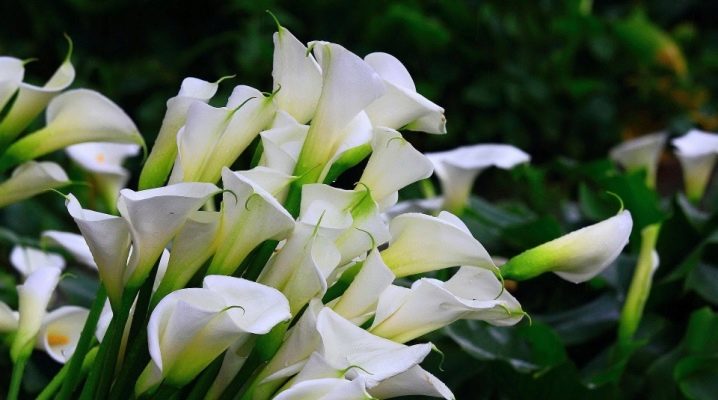
The variety of flowers in nature is enormous, and thanks to knowledge in the field of floriculture, a person can grow many of them at home. White calla lilies are rightfully considered one of the most beautiful and spectacular plants that can be presented as a bouquet or cultivated indoors. In order for them to please with their beautiful appearance, you need to know the features of these flowers and the subtleties of their cultivation.
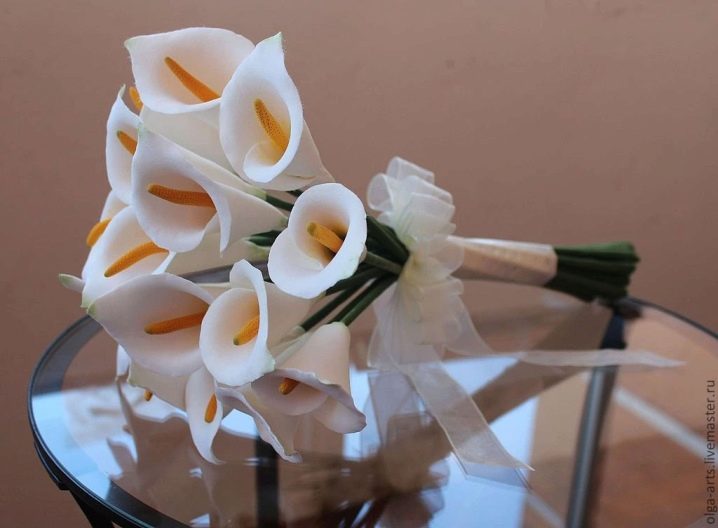
Description
The calla plant (calla lily) is an unusual and beautiful flower with large green leaves and white flowers, the edges of which curl like a bride's wedding dress. Its petioles are straight and even, long and wide green leaves are held on them. Since the culture came to us from Africa, it has its own characteristics of growth and cultivation.
Due to the presence of various varieties and species, the popularity of calla lilies remains consistently high, and they can be seen as a decoration for a room for a holiday or as a decorative flower in a pot or outdoors.
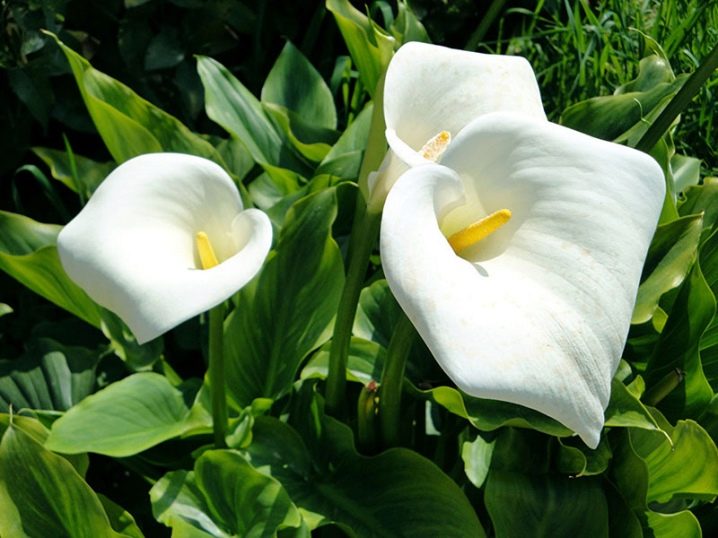
Among the most common types of calla lilies are:
- Ethiopian rhizome;

- white spotted.
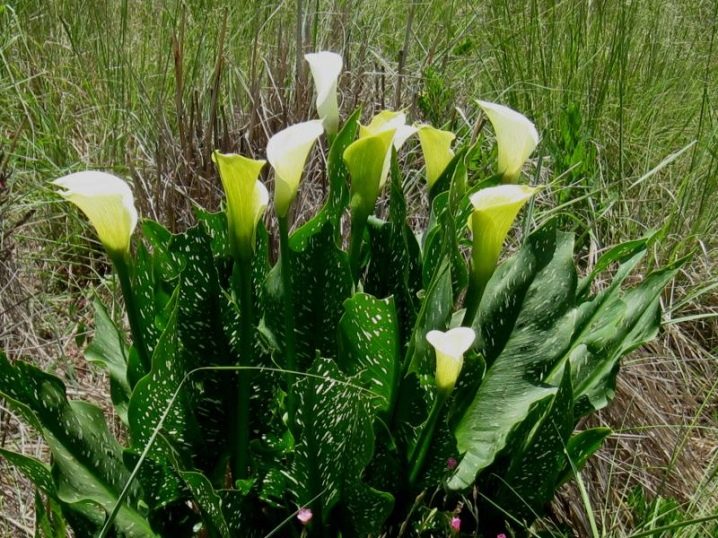
Ethiopian calla is represented by bright green leaves and white flowers. On the foliage of the white-spotted version, there are white dots, which give the plant an elegant and attractive appearance.
Among the most popular calla lilies shades are:
- white;
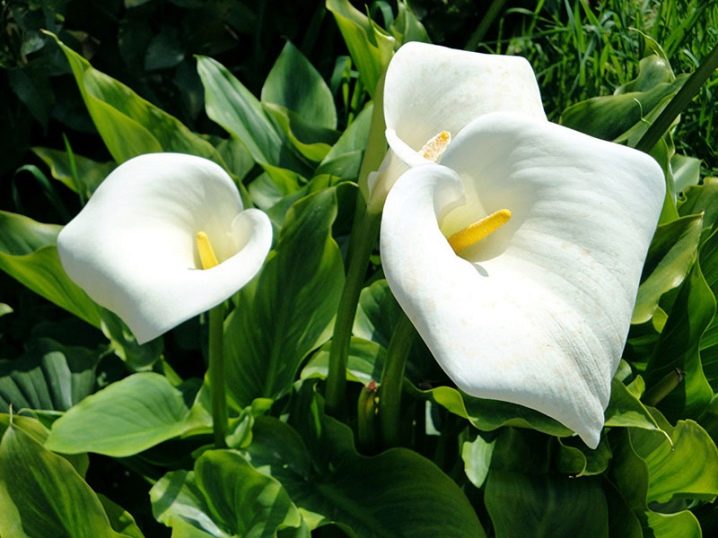
- pink;
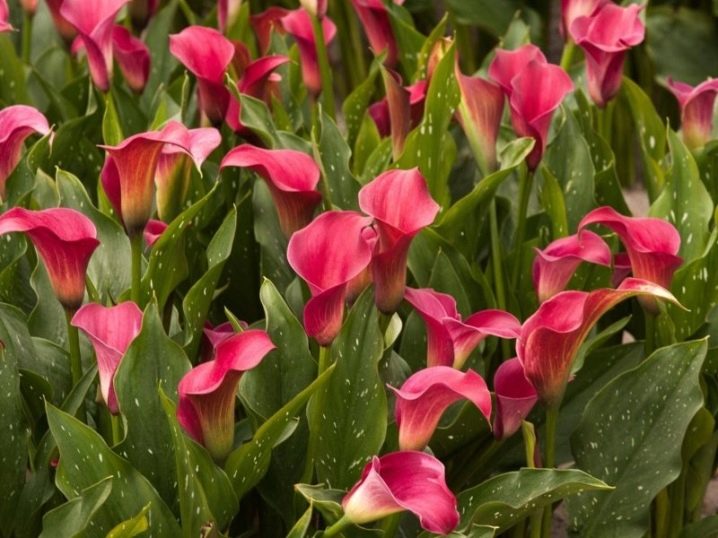
- orange;
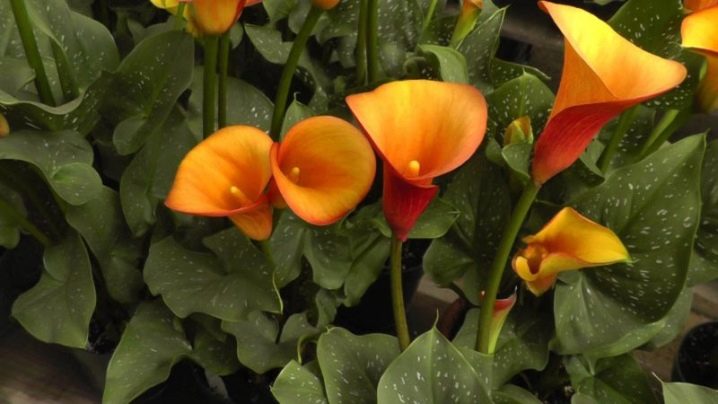
- yellow;
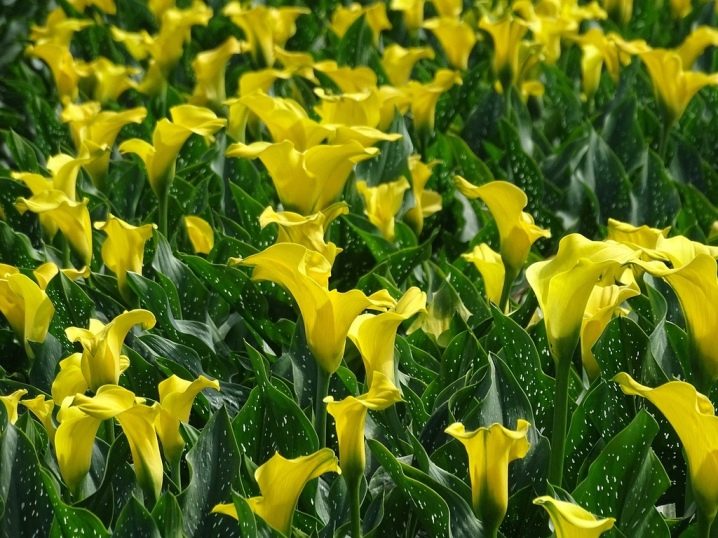
- purple.

The color variety of varieties speaks not only about their different pigments, but also about the peculiarities of cultivation, therefore, before choosing any kind of calla for yourself, you need to find out about the specifics of its cultivation. The most popular are white calla lilies, which are highly decorative plants., belonging to the Aroid family and represented by one species - the marsh calla, which will be discussed later.

Landing
The marsh calla grows in the natural environment near swamps and water bodies. For full development, the plant needs a sufficient amount of moisture and an optimal temperature regime. Due to the decorativeness of the culture, it is grown in pots and in the local area. To get rich and beautiful flowering, it is important to take proper care of it.
If planting is carried out in a pot, then calla tubers must be purchased. They are transported in the substrate or sawdust from which they need to be removed. For good rooting in a new place, you need to dip the bulb in a special solution for several hours. While the tubers are cooking, you need to tackle the soil.
A feature of callas is the need for a large pot, where the root system can feel as free as possible.



For the smallest tuber, you need to purchase a pot of at least 2 liters. The size of the container will grow depending on the size of the bulb. The bottom of the pot should be covered with drainage at least 5 centimeters high, after which the most nutritious soil is poured. It is worth calculating the amount of soil in the pot correctly. Its height should not reach the edges of the container. It is also worth leaving about 10 centimeters of free space on top, unfilled with earth.
The soil must be well tamped and watered with a specialized solution, which will contribute to the faster rooting of the culture.
Subsequent feeding will take place with solutions that will nourish the plant itself, and not stimulate root growth.
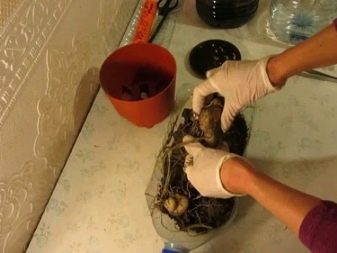

When the pot of soil is ready, you can grab the tuber. Before planting it, you need to determine its upper and lower sides. The smooth part will be at the bottom and the rosette will be at the top. Roots will begin to appear from the outlet in the future, therefore it is so important to place it correctly in the pot. After that, a small layer of the same nutritious soil is poured on top and the pot is placed in a warm place. It is important to protect the future flower from drafts and prevent the soil from drying out.

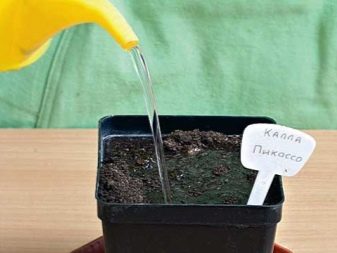
If you plan to plant calla lilies in the garden, then the tuber transplant can be started immediately after the frosts have passed. To achieve rapid growth of a flower in a new place, it is worth transferring it along with an earthen lump in which it hibernated. For a plant to grow well, it is important to prepare the right soil for it. It should be light and acidic, and therefore peat, humus, leafy earth and sand in a ratio of 1: 1: 1: 0.5 will be the optimal combination.
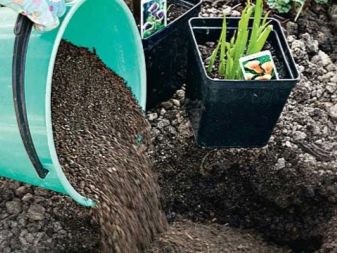
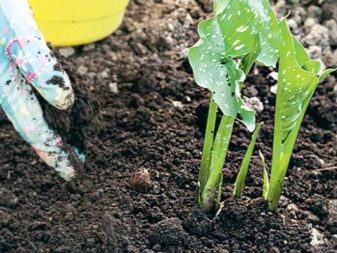
Calla lilies begin to bloom in June, and ends in October, after which preparations for a dormant period begin. Flowers retain their appearance from one to one and a half months. One plant can have about 10 peduncles.
To achieve good growth and flowering, it is important to create optimal conditions for him, without which you can very quickly lose such a beautiful culture.
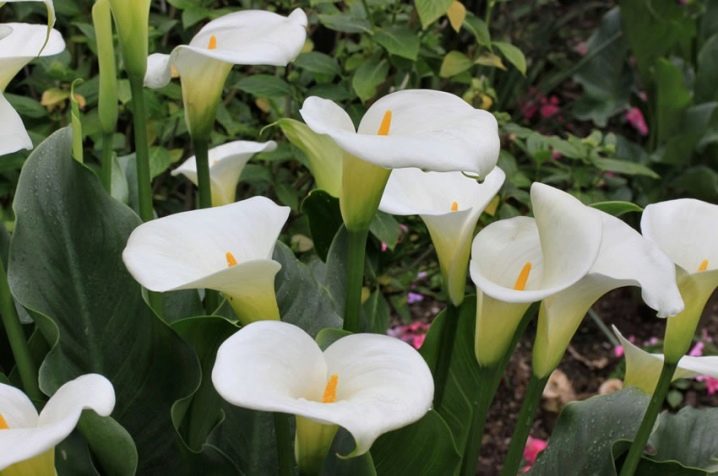
Care
The procedure for caring for calla lilies at home is not a particularly difficult process, but without the necessary knowledge about temperature indicators, the amount of moisture introduced, feeding, lighting features, it is difficult to properly grow this culture. You need to be able to choose the right soil for a new pot, plant and propagate the plant correctly. Information about diseases and pests that can be encountered while growing calla lilies will also be important. Caring for it will not cause difficulties for someone who will be completely ready for this process, otherwise you will not have to admire the spectacular flowers of the plant.
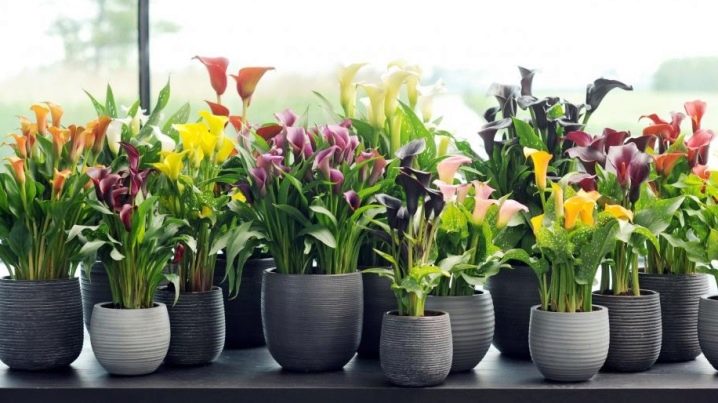
Top dressing
Calla can grow both in a pot and outdoors. Potted crops need mandatory feeding, especially during active crop growth. Those flowers that are planted outdoors will be less demanding on additives, because most of the necessary substances will be able to draw from the soil.
A culture that grows at home needs fertilization with special solutions that can be purchased at any flower shop: superphosphate, ammonium nitrate and the like.


The feeding procedure is carried out twice a month. For the full growth and development of a flower, it is necessary to apply complex mineral fertilizers, alternating them with organic additives. During the growing season, it is important to refrain from using nitrogen-containing preparations. With the appearance of peduncles, the introduction of urea is recommended, and when the flowers begin to bloom, a good option would be to use an infusion of eggshells.

The substances should equally affect the root and the green part of the plant. During the introduction of the composition, you should avoid getting it on the flowers, otherwise they will quickly deteriorate. With proper and timely feeding, you can achieve good bulb growth, which will make it possible to fully develop the ground part of the flower and delight the owners with stable and long flowering.
Watering
Indoor calla lilies are quite demanding for watering, so you should pay special attention to this. During the period of growth, development and flowering, the introduction of moisture into the pot should be stable and significant. The main rule that you should know about and adhere to is not to fill the flower so that the water is in the pot. If you do not follow this recommendation, this will lead to acidification of the soil and the death of the root system, after which the flower itself will die.
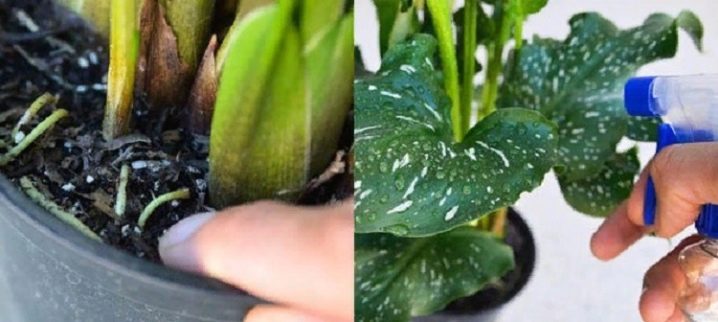
The optimal time for watering is when the top of the soil has dried to a depth of about a centimeter. Stagnant water is as dangerous as its shortage.White calla lilies do not like drought very much and die from it in the shortest possible time, so do not forget about watering this plant. Like many ornamental plants, calla lilies have a dormant period, which takes place in the summer. During this period, there is a need to stop watering and place the flower in a dark and cool room.
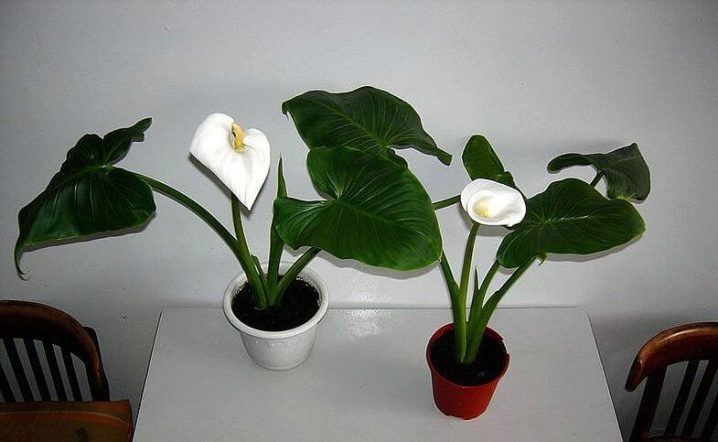
The colored variety of calla lilies differ from white ones in that the watering process may be less frequent due to the possibility of retaining moisture in the tubers, so you can wait until 3-4 cm of the top layer dries, and then water them. Another significant difference is the dormant period - colored varieties rest in winter, and it is at this time that watering must be completed and all the proper conditions for plant rest must be created.
The frequency of watering and the amount of moisture increases during the flowering period and decreases slightly afterwards.
For flowers that are planted in the open air, it is worth finding a place next to which there will be a natural source of moisture, which will make it possible to water the culture much less often.

Lighting
Like most flowers, calla lilies like bright, long-lasting light throughout the day. Direct sunlight will harm the flower, so it is best to place the pot in a place where the light will be indirect. Daylight hours should be from 10 to 12 hours during the active growth of the culture. To maintain this duration in the autumn-winter season, special lamps with a power of about 700 Lux will be needed.
If there is too little light, then for a white calla it threatens with a lack of flowering, and for a colored calla - with pale and expressionless flowers. The optimal location of the pot will be western and eastern windows, where there will be enough light, but the sun will not hit the flower. If the plant is located on the south window, it should organize a shade to protect it from the scorching rays, and on the north window it is necessary to install a special lamp to compensate for the lack of lighting.
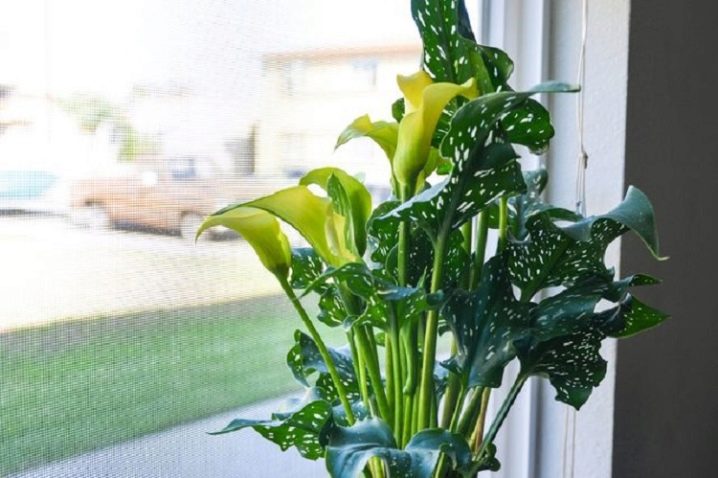
Temperature
For calla lilies growing indoors, it is important to maintain the correct temperature readings. In the summer, the room should be about 20 degrees Celsius for the white varieties, and 20-25 for the colored ones. In order for the culture to grow and develop correctly, it is worth protecting it from sudden changes in temperature and avoiding drafts. You should not put the pot on the balcony or near an open window, because this will negatively affect the calla.
Winter is a dormant period for the colored variety. The temperature should be reduced to 10-15 degrees. Since colored calla lilies practically do not grow in winter, they can even be taken out of the pot and kept in sawdust throughout their hibernation. To keep the plant alive, it is important to lower the temperature to 3-5 degrees Celsius, as well as arrange the tubers so that the growing point is at the top.
As soon as winter is over, you can put the feces back in their place and, with the onset of spring, start watering and full-fledged care for it, gradually raising the ambient temperature to summer indicators.
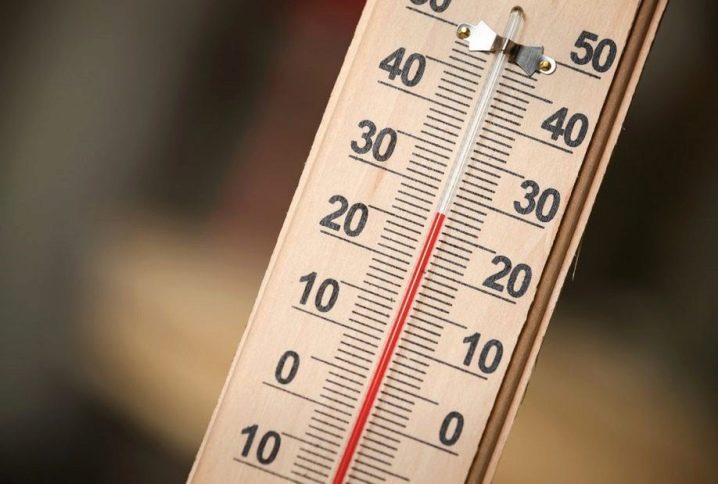
Possible problems
Calla is not a very whimsical and painful plant, but with improper care of it you can find such problems:
- faded and drooping leaves;
- curling the tips of the leaves up;
- dying and poorly developed flowers;
- holes in the leaves.
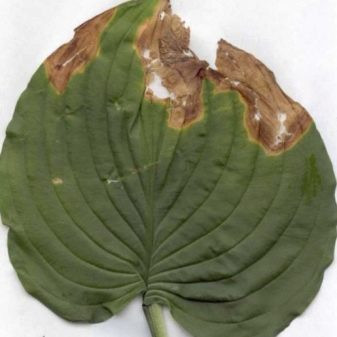

This can be caused by diseases and plant pests. Among the diseases, the most common are:
- root and gray rot;
- powdery mildew;
- anthracnose.
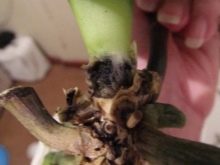


Among the pests on the plant, you can find:
- aphids;
- shield;
- false shield;
- spider mite.
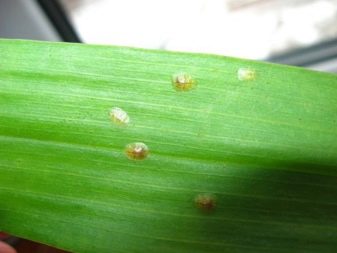
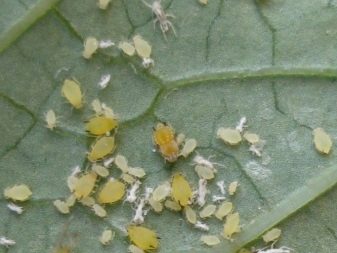
To identify the problem, you need to carefully examine all parts of the plant for any changes in appearance or the presence of neoplasms, correctly determine their nature and immediately begin to fight them. If you miss the moment, you may not have time to save the flower.
How to grow calla lilies, see the next video.




































































































The comment was sent successfully.